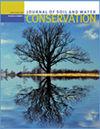Critical shear stress variability in claypan soils with depth
IF 2.6
4区 农林科学
Q2 ECOLOGY
引用次数: 0
Abstract
Soil erosion from land management activities reduces agricultural productivity and contaminates waterways. Understanding erosion processes within agricultural fields is critical to developing alternative management scenarios to better manage soil resources. Claypan soils comprise approximately 5% of the agronomic area in the US Midwest; however, little is understood about the erosion characteristics within the claypan soil profile. Claypan soils are defined by a dense, impermeable layer that is more resistant to erosion. In this study, we used geotechnical methods to examine claypan soils in agricultural fields in southeast Kansas that showed a rapid transition from high clay to low clay content on the soil surface. Laboratory erosion measurements with an erosion function apparatus (EFA) demonstrated a two-layer soil system at both locations. At Site 1, we found a high plasticity clay layer at 25 cm depth in the soil profile, with a hydraulic conductivity 100-fold less than the surface soil, an unconsolidated undrained triaxial strength more than double that at the surface, and a critical shear stress that was on average five times higher than that measured in the surface layer. This high plasticity clay layer dissipated, with lower elevation locations showing similarities in soil strength and critical shear stress at the surface and 25 cm in the soil profile. At Site 2, laboratory experiments showed a similar two-layer soil structure, though the clay layer did not dissipate but instead remained at a lower position in the soil profile. In situ erosion measurements with a field jet erosion test (JET) apparatus showed a higher critical shear stress and lower erosion rate in the soils above the claypan. Soils not in the claypan area showed greater similarity in critical shear stress and erosion rate with depth in the profile. Calculating erodibility coefficient as a function of critical shear stress using the JET test results identified a cluster of measurements with very high critical shear stress and low erodibility. This cluster of soils were located on the claypan area as they were collected 25 cm down. These results reveal some of the sources of variability found in claypan soils and indicate the need for more careful planning to manage the soil that will result from the compositional changes. Management practices to reduce erosion will also require alternative approaches to accommodate the inherent spatial variability of soils and changes within the soil profile.粘性土临界剪应力随深度的变化
土地管理活动造成的土壤侵蚀会降低农业生产力,并污染水道。了解农田内的侵蚀过程对于制定替代管理方案以更好地管理土壤资源至关重要。在美国中西部地区,粘土土壤约占农田面积的 5%;然而,人们对粘土土壤剖面的侵蚀特征却知之甚少。粘土层的特点是致密、不透水,具有较强的抗侵蚀能力。在本研究中,我们使用岩土工程方法对堪萨斯州东南部农田中的粘土进行了研究,发现土壤表面的粘土含量从高迅速过渡到低。使用侵蚀功能仪 (EFA) 进行的实验室侵蚀测量表明,这两个地点的土壤系统均为双层。在站点 1,我们在土壤剖面 25 厘米深处发现了一个高塑性粘土层,其导水率比表面土壤低 100 倍,未固结不排水三轴强度是表层的两倍多,临界剪应力平均比表层测量值高五倍。这种高塑性粘土层逐渐消散,在海拔较低的地点,表层和土壤剖面 25 厘米处的土壤强度和临界剪应力相似。在 2 号站点,实验室实验显示了类似的两层土壤结构,但粘土层并未消散,而是保持在土壤剖面的较低位置。使用现场喷射侵蚀试验(JET)仪器进行的原地侵蚀测量显示,粘土层上方的土壤临界剪应力较高,侵蚀率较低。而不在粘土层区域的土壤,临界剪切应力和侵蚀率随剖面深度的变化更为相似。利用 JET 测试结果计算侵蚀系数与临界剪应力的函数关系,发现了一组临界剪应力很高而侵蚀率很低的测量结果。这组土壤位于粘土区,因为它们是在 25 厘米以下采集的。这些结果揭示了粘土层土壤中的一些变异性来源,并表明有必要对成分变化所导致的土壤管理进行更仔细的规划。减少侵蚀的管理方法也需要采用其他方法,以适应土壤固有的空间变异性和土壤剖面内的变化。
本文章由计算机程序翻译,如有差异,请以英文原文为准。
求助全文
约1分钟内获得全文
求助全文
来源期刊
CiteScore
4.10
自引率
2.60%
发文量
0
审稿时长
3.3 months
期刊介绍:
The Journal of Soil and Water Conservation (JSWC) is a multidisciplinary journal of natural resource conservation research, practice, policy, and perspectives. The journal has two sections: the A Section containing various departments and features, and the Research Section containing peer-reviewed research papers.

 求助内容:
求助内容: 应助结果提醒方式:
应助结果提醒方式:


